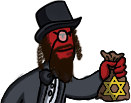Karellen
Arcane
- Joined
- Jan 3, 2012
- Messages
- 327
I can't help but thinking, is this how thin their pitches are to publishers? Maybe that's why they fail so much.
Not that I disagree with having better pitches, but I truly fail to see which of the successful Kickstarters provided substantially more information. Actually, a lot of them had less. If you look at successful pitch videos, they're composed of namedropping, some pandering, comedic "Take that!" zingers about the traditional publisher model to appeal to the bitter hardcore gamer, and then maybe some really vague descriptions of which games (often quite dissimilar) the game is meant to resemble. Gameplay footage? Mockups? Concept art? Design documents? You don't get any of that, you get people who talk to you to tug at your heartstrings, and subsequently your purse strings.
Others might not have substantially more information, but they did have some information. but more importantly, they revealed information in their updates. I think this could have been a cool Project, but I got the feeling they are not even sure themselves were they will take it.
See, I really do think that they have a simple, coherent idea behind their game. Basically they want to make a short "rogue-like" tactical RPG with inevitable character death and emphasis on replayability. The idea is that with this feature set, a normal, semi-casual player might be persuaded to, if not play in real
 Iron Man mode, at least accept unit losses on the tactical level, so they'd actually use the strategy layer to deal with setbacks instead of savescumming their way out of everything. They never really come out and say this clearly, though - I'm just inferring it from the features they talk about, because I play tactical RPGs a lot and I see the problem and how some of their design choices might counteract it. So who knows?
Iron Man mode, at least accept unit losses on the tactical level, so they'd actually use the strategy layer to deal with setbacks instead of savescumming their way out of everything. They never really come out and say this clearly, though - I'm just inferring it from the features they talk about, because I play tactical RPGs a lot and I see the problem and how some of their design choices might counteract it. So who knows?What's obvious, though, is that a lot of people - particularily the ones who post on their forums - don't see it like this. Instead they appear to be convinced that it's a game where between incidental fights they get to play house with their characters, make them fall in luuuurve and get them to make babies whose growth they can minutely oversee like some kind of creepy, computerized helicopter parents. Correcting their misunderstanding at this point would just make them feel angry and betrayed, and maybe pull out their money, so I'm guessing that the devs will just wait until the campaign is finished before they make clear what they're actually doing, and throw in a couple of mostly irrelevant micromanagement features in the final game as a conciliatory gesture so they can claim that they actually listen to their fans. At least I hope so, because if they do that, the game might end up being pretty interesting.


























![Glory to Codexia! [2012] Codex 2012](/forums/smiles/campaign_tags/campaign_slushfund2012.png)



 They could have at least do some research before putting up another kickstarter. Not just: "we'll show Tim Schafer and rake in money like the first time".
They could have at least do some research before putting up another kickstarter. Not just: "we'll show Tim Schafer and rake in money like the first time".

